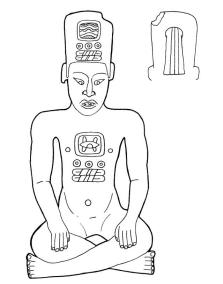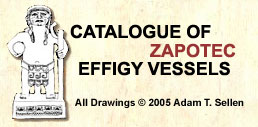| Key: MCO 0012 | | Actual Location: Museum of Cultures of Oaxaca, City of Oaxaca, Mexico (exhibited). | | Collection: José Juan Canseco 1850 | | Registration: Cat. 0012/INAH 10-104350 | | Provenance: Zaachila (Peñafiel 1893: 24) ; Mitla (F. León 1903?: 115); Cuilapan (N. León 1905: 403). | | Measurements: 33.5 x 17.5 cm. | | Color: Polished brown clay with traces of red pigment. | | Chronology: Niza 100 BC - 200 AD | | Click to view Chronology | | Reference: Peñafiel 1893: 24-25; Calderón León 1903?: 115 [description]; Nicolás León, Mayan Hieroglyphs, 1896 & 1905: 403, plate 1, fig. 1; Caso 1928 (reproduction of the glyphs); Keleman 1943: vol. II, plate 123 d; Toscano 1944: 432; Covarrubias 1946: fig. 18; C | | Comments: There is a head with the same properties as this piece (cf. Caso and Bernal, 1952: 337, fig. 500bis). There is also a complete piece at the Cleveland Museum (CMA 54.857). About the pieces, Caso and Bernal comment: "We do not know if we should include it with the figures of period II, because we have not found in Monte Albán, during our stratigraphic explorations, any objects of this style and the two that exist come from the old collections of the National Museum and the Museum of Oaxaca" (1952: 337). It was always said that this piece came from Cuilapan, but it seems to have been a mistake from León, as from the very beginning, it was established that its provenance was Zaachila. | | Glyphs: Glyph 13 for water in the headdress and 13 Q on the chest. Bernal (1979: 103) interprets the glyphs as 13 water and 13 alligator's eye. | |
| | 
Click to view high resolution in a new window
select this image for review |
